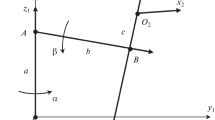Abstract
An exact solution is obtained for the kinetic energy in the general case of spatial movement of rigid bodies with arbitrary rotation including a change in the products of inertia. The Lagrangian description of the movement and the principle of superposition, which provides the geometric summation of velocities and accelerations of cooperative Lagrangian movements for any particle at any instant of time, are used. The integrand in the equation for the kinetic energy is represented as the sum of the same velocity components of cooperative plane-parallel movements. The polar moments of inertia are not changed during movement, and they can be calculated by the current or initial state of the body. The products of inertia are changed and become zero during rotation with respect to the principal central axes only for bodies with the same principal moments of inertia, for example, for a sphere. In other cases, the difference in the principal moments of inertia leads to cyclic changes in the kinetic energy with possible manifestation of precession and nutation, the amplitudes of which are dependent on the angular rotational velocities of the body. An example using equations for a robot with one screw and two rotational kinematic pairs is presented.

Similar content being viewed by others
REFERENCES
Kozyrev, Yu.G., Promyshlennye roboty. Osnovnye tipy i tekhnicheskie kharakteristiki (Industrial Robots: Main Types and Characteristics), Moscow: KNORUS, 2015.
Poduraev, Yu.V., Mekhatronika. Osnovy, metody, primenenie (Mechatronics: Foundations, Methods, and Application), Moscow: Mashinostroenie, 2006.
Mekhanika promyshlennykh robotov, Vol. 1: Kinematika i dinamika (Mechanics of Industrial Robots, Vol. 1: Kinematics and Dynamics), Frolov, K.V. and Vorob’ev, E.I., Eds., Moscow: Vysshaya Shkola, 1989.
Korendyasev, A.I., Teoreticheskie osnovy robototekhniki (Theoretical Foundations of Robotics), Moscow: Nauka, 2006.
Li, D.-Q., Hong, H.J., and Jiang, X.L., Dynamics modeling, control system design and simulation of manipulator based on Lagrange equation, Mechanism and Machine Science. ASIAN MMS 2016, CCMMS 2016, Zhang, X., Wang, N., and Huang, Y., Eds., Lecture Notes in Electrical Engineering, vol. 408, Singapore: Springer, 2017, pp. 1129–1141. https://doi.org/10.1007/978-981-10-2875-5_91
Lukinov, A.P., Proektirovanie mekhatronnykhi robototekhnicheskikh ustroistv (Design of Mechatronic Robotic Devices), Moscow: Lan’, 2012.
Liu, X.-J., Wang, Q.-M., and Wang, J., Kinematics, dynamics and dimensional synthesis of a novel 2-DoF translational manipulator, J. Intell. Rob. Syst., 2004, vol. 41, no. 4, pp. 205–224. https://doi.org/10.1007/s10846-005-3507-z
Berbyuk, V.E., Dinamika i optimizatsiya robototekhnicheskikh sistem (Dynamics and Optimization of Robotic Systems), Moscow: Fizmatlit, 2011.
Hwang, Y.-L., Cheng, J.-K., and Truong, V.-T., Dynamic analysis and control of industrial robotic manipulators, Appl. Mech. Mater., 2018, vol. 883, pp. 30–36. https://doi.org/10.4028/www.scientific.net/AMM.883.30
Kulakov, F.M., Alferov, G.V., and Malafeev, O.A., Dynamic analysis of effector system of robotic manipulators, Probl. Mekh. Upr.: Nelin. Din. Sist., 2014, no. 46, pp. 39–46.
Zhuravlev, V.F., Osnovy teoreticheskoi mekhaniki (Foundations of Theoretical Mechanics), Moscow: Mosk. Fiz.-Tekh. Inst., 2008.
Gernet, M.M., Kurs teoreticheskoi mekhaniki (Course of Theoretical Mechanics), Moscow: Vysshaya Shkola, 1987.
Alyushin, Yu.A., Mekhanika tverdogo tela v peremennykh Lagranzha (Rigid-Body Mechanics in Lagrangian Variables), Moscow: Mashinostroenie, 2012.
Alyushin, Yu.A., Principle of motion superposition in the space of Lagrange variables, Probl. Mashinostr. Nadezhnosti Mash., 2001, no. 3, p. 13.
Feodos’ev, V.I., Soprotivlenie materialov (Strength of Materials), Moscow: Mosk. Gos. Tekh. Univ. Baumana, 1999, 10th ed.
Rabotnov, Yu.N., Mekhanika deformiruemogo tverdogo tela (Mechanics of Deformable Solid Body), Moscow: Nauka, 1979.
Alyushin, Yu.A. and Verzhanskii, P.M., Strukturnyi, kinematicheskii i dinamicheskii analiz rychazhnykh mekhanizmov (Structural, Kinematic, and Dynamic Analysis of Linkage Mechanisms), Moscow: Mosk. Inst. Stali i Splavov, 2015.
Author information
Authors and Affiliations
Corresponding author
Ethics declarations
The author declares that he has no conflicts of interest.
Additional information
Translated by Yu. Ryzhkov
About this article
Cite this article
Alyushin, Y.A. Calculation of the Kinetic Energy of a Rigid Body in the General Case of Three-Dimensional Motion with Arbitrary Rotation. J. Mach. Manuf. Reliab. 51, 9–19 (2022). https://doi.org/10.3103/S1052618822010022
Received:
Revised:
Accepted:
Published:
Issue Date:
DOI: https://doi.org/10.3103/S1052618822010022




